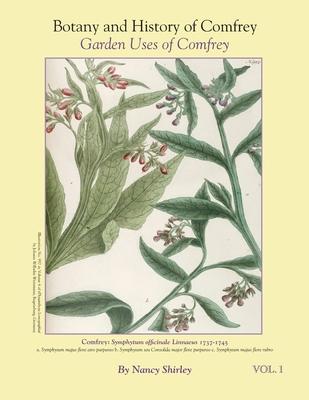Botany and History of Comfrey
Garden Uses of Comfrey
This book has in-depth research on Comfrey (Symphytum) using historical documents, botanical literature, biomedical literature, modern research papers, academic dissertations, government resources, databases, maps, articles, books, and magazines in many languages from many countries.
It is illustrated with artwork from the years 1555 to 1913.
All species and many subspecies of Comfrey are described including the more known species such as Symphytum officinale (Common Comfrey), Symphytum x uplandicum (Russian or Quaker Comfrey), Symphytum asperum (Prickly Comfrey), and Symphytum tuberosum (Tuberous Comfrey). The history and current accepted botanical naming is referenced. There are detailed descriptions of the leaves, roots, flowers and seeds. Chromosomes and breeding are discussed in pure species and hybrids. Geographic locations are given.
There is much information about the history of Comfrey throughout the world, starting with Herodotus in Greece in 425 BC. It includes: Pliny the Elder in Rome in 79 AD, Anglo-Saxon Leech Books from 900-1000 AD, Hildegard of Bingen in Germany in 1179 AD, Jean Ruel in France in 1536, Paracelsus in Switzerland in 1541, John Gerard in England in 1597, John Parkinson in England in 1640, Thomas Christy in England in 1790, Henry Doubleday in England in the late 1800s, Lawrence Hills in England wrote comfrey books in 1953/1975/1976, and many more historical figures.
The book references these and other botanists:
Bauhin 1596 &1623, Parkinson 1640, Ray 1669 & 1686, Tournefort 1700, Linnaeus 1753, Gaertner 1788, Schreber 1789, Jussieu 1789, Schkuhr 1791, Lamarck 1791, Sowerby 1791, Sibthorp 1794, Schmidt 1794, Lepechin 1797, Willdenow 1799, Bieberstein 1808, Lehmann 1818, Schimper 1835, G. Don 1838, Fries 1839, De Candolle 1846, Ledebour 1847, Steven 1851, Bentham 1858, Kerner 1863, Schur 1866, Schultz 1875, Boissier 1879, Nyman 1881 & 1884, Kuntze 1887, Kuznetsov 1910, Bucknall 1912 & 1913, Tutin 1952, Komarov 1953, Popov 1953, Wade 1958, Perring 1962, Gadella and Kliphuis 1967, Wickens 1969, Pawlowski 1972, Perring 1975, Stearn 1985 & 1986, Sandbrink 1990, Slavik 2000, Elci/Hilger/Erik 2008, Hacioglu and Erik 2011, Gviniashvili 2013.
Gardening with Comfrey shows how to use it as a mulch, soil conditioner, dynamic accumulator, liquid fertilizer (Comfrey tea), compost activator, and potting amendment. This perennial helps the growth of vegetables and fruit, especially potatoes. It is popular in permaculture and forest gardens. Beneficial insects love comfrey.
Analysis gives the nutritional value of Comfrey with amounts of protein, fiber, minerals, vitamins and mucilage. Studies of the digestibility of the leaf are provided.
